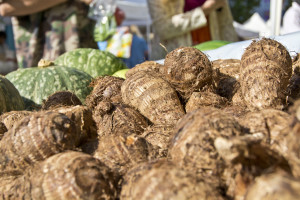Farmers Market
Most everyone knows how taro root is made into Hawaiian poi, a somewhat colorless gray starchy mixture with the texture of pudding. But roasting or baking can bring out a sweet nutty flavor. The cooked taro leaves are also tasty in Asian soups and stir fry dishes.
 Taro is a starch-rich, globular fleshy taproot of aroid family plants. Its underground root is one of the popular edible root vegetables in large parts of Asia, the Pacific Islands, West Africa, and the Amazonian regions of South America. It has beautiful large heart-shaped leaves sometimes called “elephant ears.” The root, or “corm,” is about the size of a turnip and has a rough brown outer skin. The delicious crisp meat becomes soft and edible once cooked and has a flavor somewhat like water chestnuts. Asian specialty produce growers like Her Farm of Fresno, Vang Vegetable Farm of Merced, or Xiong Farm of Stockton harvest taro root and taro leaves during the fall months.
Taro is a starch-rich, globular fleshy taproot of aroid family plants. Its underground root is one of the popular edible root vegetables in large parts of Asia, the Pacific Islands, West Africa, and the Amazonian regions of South America. It has beautiful large heart-shaped leaves sometimes called “elephant ears.” The root, or “corm,” is about the size of a turnip and has a rough brown outer skin. The delicious crisp meat becomes soft and edible once cooked and has a flavor somewhat like water chestnuts. Asian specialty produce growers like Her Farm of Fresno, Vang Vegetable Farm of Merced, or Xiong Farm of Stockton harvest taro root and taro leaves during the fall months.
Taro is one of the finest sources dietary fibers, having 4 grams of fiber per serving. It also has good quantities of vitamin A, niacin, and thiamin. Buy fresh, firm, medium size hairy corms that feel heavy in hand for their size. Avoid those with soft spots, cracks, or featuring sprouts at the scales.
Fresh corms should be stored in cool, dark, well-ventilated place like potato, yams, etc. Do not keep them inside the refrigerator. Taro greens, however, should be placed inside the refrigerator similar to other greens.
Taro root is inedible when raw and considered toxic due to the presence of calcium oxalate crystals. Taro corms and leaves should be processed and boiled before eating as they can be unpleasantly bitter and harmful for health when eaten raw. However, the plant parts are very safe after cooking (boiling, frying, or steaming).
The corms, which have a light purple color due to phenolic pigments, can be roasted, baked, steamed or boiled, and the natural sugars give a sweet nutty flavor. The starch is easily digestible, and since the grains are fine and small it is often used for baby food. The leaves are a good source of vitamins A and C and contain more protein than the corm. The leaves are only edible when cooked and can be prepared in a variety of ways including boiling, frying, and baking. In Hawaii, it’s used to make the famous poi.

